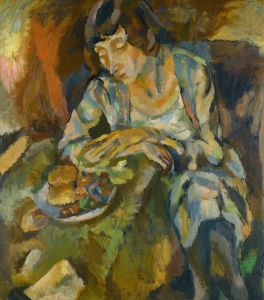
Fille à la mandoline
A hand-painted replica of Jules Pascin’s masterpiece Fille à la mandoline, meticulously crafted by professional artists to capture the true essence of the original. Each piece is created with museum-quality canvas and rare mineral pigments, carefully painted by experienced artists with delicate brushstrokes and rich, layered colors to perfectly recreate the texture of the original artwork. Unlike machine-printed reproductions, this hand-painted version brings the painting to life, infused with the artist’s emotions and skill in every stroke. Whether for personal collection or home decoration, it instantly elevates the artistic atmosphere of any space.
Jules Pascin, a Bulgarian-born artist who became a prominent figure in the École de Paris, created numerous works that reflected his unique style and perspective. Among his notable paintings is "Fille à la mandoline" (translated as "Girl with a Mandolin"). This artwork exemplifies Pascin's characteristic approach to portraiture, blending elements of modernism with a sensitivity to the human form.
"Fille à la mandoline" portrays a young woman holding a mandolin, a stringed musical instrument. The painting is marked by Pascin's delicate use of color and line, which lend a sense of intimacy and softness to the composition. His technique often involved muted tones and subtle shading, creating a dreamlike quality that is evident in this work. The subject's pose and expression convey a quiet introspection, a recurring theme in many of Pascin's portraits.
Pascin's artistic career was deeply influenced by his travels and the cultural milieu of early 20th-century Europe. Born in 1885 in Vidin, Bulgaria, he moved to Paris in 1905, where he became associated with the Montparnasse art scene. His work often depicted women, capturing their emotions and individuality with a blend of realism and abstraction. "Fille à la mandoline" fits within this broader context of his oeuvre, showcasing his ability to merge technical skill with emotional depth.
The exact date of creation for "Fille à la mandoline" is not definitively documented, but it is consistent with Pascin's mature period, during which he produced many of his most celebrated works. As with much of his art, this painting reflects his interest in the human figure and his ability to convey a sense of narrative through subtle visual cues.
Jules Pascin's life was marked by both artistic success and personal struggles. Despite his acclaim, he battled depression and tragically took his own life in 1930. His legacy, however, endures through his contributions to modern art, and "Fille à la mandoline" remains a testament to his talent and vision.
Further details about the current location or ownership of "Fille à la mandoline" are not widely available, as many of Pascin's works are held in private collections or museums around the world. This painting continues to be appreciated for its artistic merit and its place within the broader narrative of Pascin's career.


















